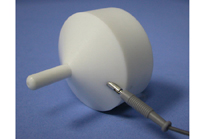 Presentation
PresentationMany different animal models have been developed for testing the effects of
anti-anxiety drugs on behaviour. The most frequently behavioural action is the anxiolytic ability to increase response rates suppressed by delivery of response-dependant punishment.
One of the most popular versions of this technical approach is that developed by
R.A. Vogel in 1971 (Psychopharm. (Berl.), 21:1-7). In this model, licking of drinking tube suppression in water-deprived rats, is reestablished by anxiolytic pretreatment. As the model can be used with naive rats in one test session, it has become a
standard for fast screening of anxiolytic activity of drugs.
 Operating principle
Operating principleOur instrument is a fully automated set up fulfilling all the control needs of the Vogel's Test, and allowing test performance in a single and easy to use experimental unit.
The set-up is formed by the animal cage, and a modular control unit that include a shock generator.
The animal cageThe animal cage is made up of black perspex with an upper access door and an electrificable grid floor (stainless steel bars, 4 mm dia., spaced 10 mm); frontal panel & upper door are made of transparent perspex. The drinking tube is installed in one of the box sides; it is provided with a resistive detector for animal approaches to water and allows measuring of water consumption and water loss.
Lick detection is established through the drinking water, in such a way that only the consummatory behaviour is intended to be a response (this system has proved to be much more reliable than others, based on animal contact with the drinking tube, in which false responses due to contacts with the drinking tube without drink are possible).
The LE10025 Control UnitThe LE10025 Control Unit provides full control over all the parameters necessaries to carry out the Vogel's test, including those related with shock administration through a built-in shock generator.
The LE10025 is a microprocessor based instrument, with a 2 x 20 characters LCD and a mixed numeric & functions keyboard. Selecting the appropriate option in the controlling 'menu', it is possible to define the number of licks to be reached before a shock is given (up to 9999) and the total length of the experimental session (59:59 mm:ss).
Once a START key is pressed, a new trial begins, with the parameters currently defined. Licks and shock counters , as well as session timer are reset; the lick counter is increased with each new lick until reaching the pre-defined lick/schock ratio. A shock is then activated (intensity and duration must be selected separately using the appropriate control) and the shock counter increased. The session ends once the pre-programmed length time is reached.
Up to 99 trials can be stored permanently in the LE10025 control unit and reviewd using the up/down arrow keys. In each trial, total number of licks and shock received during the session are available.
In the shock controlling section, the shock parameters -
duration (from 0.1 to 10 s), intensity (from 0.1 to 2 mA) and the electronic scrambler velocity (on 6 poles) - can be set through the frontal controls. The shock is delivered either manually or when an external start signal is provided by the control unit.
 Parameters Measured
Parameters Measured• Total number of licks per trial
• Total number of shocks received per trial
 Key features
Key features• Allows Vogel experiments directly into the animal's home cage
• Exclusive nipple system to exclude non-specific contacts

• Different cage available for rats and mice
• Up to 32 cages can be used with the setting associated with a computer
• Compatible with Laptop use

 Pain - Thermal Allodynia / Hyperalgesia
Pain - Thermal Allodynia / Hyperalgesia Pain - Spontaneous Pain - Postural Deficit
Pain - Spontaneous Pain - Postural Deficit Pain - Mechanical Allodynia / Hyperalgesia
Pain - Mechanical Allodynia / Hyperalgesia Learning/Memory - Attention - Addiction
Learning/Memory - Attention - Addiction Physiology & Respiratory Research
Physiology & Respiratory Research


